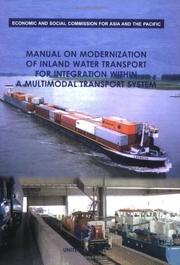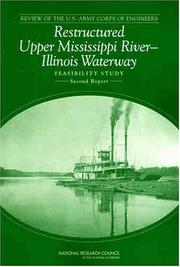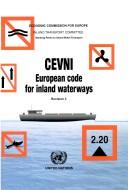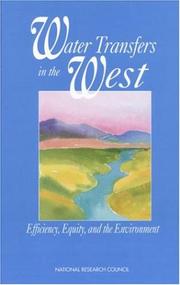| Listing 1 - 10 of 161 | << page >> |
Sort by
|
Book
Year: 2021 Publisher: London : Taylor & Francis,
Abstract | Keywords | Export | Availability | Bookmark
 Loading...
Loading...Choose an application
- Reference Manager
- EndNote
- RefWorks (Direct export to RefWorks)
"Throughout history rivers have always been a source of life and of conflict. This book investigates the Central Commission for the Navigation of the Rhine's (CCNR) efforts to secure the principle of freedom of navigation on Europe's prime river. In showing how security-prosperity considerations were a driving force in the unfolding of Europe's prime river in the nineteenth century, it is of interest to scholars of politics and history, including the history of international relations, European history, transnational history and the history of security, as well as those with an interest in current themes and debates about transboundary water governance"-- Provided by publisher.
Book
ISBN: 9210547500 9789210547505 9789211391381 9211391385 Publisher: [Place of publication not identified] United Nations Publications
Abstract | Keywords | Export | Availability | Bookmark
 Loading...
Loading...Choose an application
- Reference Manager
- EndNote
- RefWorks (Direct export to RefWorks)
This publication is the European Agreement concerning the International Carriage of Dangerous Goods by Inland Waterways (ADN), prepared under the auspices of the United Nations Economic Commission for Europe (UNECE) and the Central Commission for Navigation on the Rhine (CCNR). It includes the annexed regulations that took effect from January 1, 2011. The document serves as a comprehensive guide for the safe transport of hazardous materials through inland waterways across multiple European countries. It details regulations about the carriage of dangerous substances and articles, vessel construction and operation, as well as inspection and certification procedures. The agreement aims to standardize safety measures and facilitate international transport of dangerous goods, ensuring compliance with the highest safety standards. It is intended for use by governmental authorities, transportation companies, and professionals involved in the carriage and regulation of hazardous materials.
Hazardous substances. --- Inland water transportation. --- Hazardous substances --- Inland water transportation
Book
ISBN: 9210547519 9789210547512 9789212391243 9212391249 Year: 2011 Publisher: [Place of publication not identified] United Nations Publications
Abstract | Keywords | Export | Availability | Bookmark
 Loading...
Loading...Choose an application
- Reference Manager
- EndNote
- RefWorks (Direct export to RefWorks)
This publication details the European Agreement concerning the International Carriage of Dangerous Goods by Inland Waterways (ADN), under the auspices of the United Nations Economic Commission for Europe and the Central Commission for the Navigation of the Rhine. Effective from January 1, 2011, the agreement includes comprehensive regulations on the transport, packaging, and handling of hazardous materials, as well as the construction and certification of vessels used in such transport. It outlines the responsibilities of contracting parties, safety and security obligations, training requirements for personnel, and procedures for issuing and renewing certificates of approval. The book serves as a vital resource for policymakers, transport authorities, and companies involved in the transportation of dangerous goods within Europe. It provides updates on amendments and corrections to the regulations, ensuring compliance with European Union directives.
Inland water transportation. --- Safety regulations. --- Inland water transportation --- Safety regulations
Book
ISBN: 1527533646 Year: 2019 Publisher: Newcastle upon Tyne, UK : Cambridge Scholars Publishing,
Abstract | Keywords | Export | Availability | Bookmark
 Loading...
Loading...Choose an application
- Reference Manager
- EndNote
- RefWorks (Direct export to RefWorks)
This book contributes to the identification and systematisation of current telematics solutions applied in maritime and inland waterway transport. It represents the first time that most telematics systems currently applied in the modes of water transport have been described in detail. The volume details the massive scope of the application of telematics solutions in maritime transport, showing how it ranges from simple systems of navigation to unmanned systems which have resulted in the first attempts at launching fully autonomic vessels. The current challenges in the field involve the integration of the systems of maritime and inland waterway transport within the framework of multimodal transport operations.
Book
ISBN: 0892649038 0472127616 0472901567 9780472127610 9780892649037 9780472901562 Year: 1972 Publisher: Ann Arbor, Michigan : University of Michigan Press,
Abstract | Keywords | Export | Availability | Bookmark
 Loading...
Loading...Choose an application
- Reference Manager
- EndNote
- RefWorks (Direct export to RefWorks)
Water transport is a major feature of the traditional Chinese economy because of its magnitude and comparative efficiency. Yet this feature has all too often been ignored by scholars, with the notable exception of Japanese scholars. We cannot hope to gain any real conception of how the Chinese economy worked in the past, or works now, until we have a clearer picture of the circulation of men and commodities. In this circulation, water transport has been and is of crucial importance.Transport in Transition collects and translates notable Japanese articles to throw some light on the evolution of traditional junk shipping during a key transitional phase, 1900-1940, when it was absorbing the influences of various forms of modernization and on the eve of its major organizational transformation under the direction of the Communisty Party. The articles chosen concentrate on two main themes: the institutional organization of the shipping business, and the forms of ownership and operation. They will be of value to business historians and economic sociologists generally as well as to economic historians interested in transport.Several features of the Chinese economy are sharply illuminated. Most striking is the extent of regional variation. North and central Chinese shipping are shown to have differed both in their methods of operaiton and organization. Also noteworthy is the enduring strength of some traditional features of shipping operation and business practice. An unexpected feature of this endurance was the strength of traditional shipping in the face of steady competition from all forms of modern transport and from reputdely more efficient forms of business management.
Inland water transportation --- Shipping --- Inland shipping --- Shipping, Inland water --- Water transportation, Inland --- Inland navigation

ISBN: 9210543653 9789210543651 9211203554 9789211203554 Year: 2005 Publisher: [Place of publication not identified] United Nations Publications
Abstract | Keywords | Export | Availability | Bookmark
 Loading...
Loading...Choose an application
- Reference Manager
- EndNote
- RefWorks (Direct export to RefWorks)
This United Nations publication, produced with financial assistance from the Japan Transport Cooperation Association, addresses the modernization of inland water transport systems for integration within multimodal transport systems. It emphasizes the use of multiple modes of transport to improve efficiency, reduce costs, and enhance connectivity. The text explores definitions and concepts related to multimodal, intermodal, and combined transport, providing historical context and practical applications. The book discusses the evolution of multimodal transport, its implementation in Europe and the United States, and the importance of coordination between different transport modes for effective service delivery. It targets policymakers, transport professionals, and organizations involved in logistics and transport infrastructure planning.
Inland water transportation --- Freight and freightage --- Affreightment --- Cargo --- Freight handling --- Freight transportation --- Freightage --- Transportation --- Materials handling --- Inland shipping --- Shipping, Inland water --- Water transportation, Inland --- Shipping --- Inland navigation --- Freight --- E-books --- Inland water transportation. --- Choice of transportation. --- Choice of transportation

ISBN: 0309094364 9786610175819 1280175818 0309546257 9780309546256 9780309094368 0309182328 Year: 2004 Publisher: Washington, D.C. National Academies Press
Abstract | Keywords | Export | Availability | Bookmark
 Loading...
Loading...Choose an application
- Reference Manager
- EndNote
- RefWorks (Direct export to RefWorks)
Inland water transportation --- Hydrology. --- Inland shipping --- Shipping, Inland water --- Water transportation, Inland --- Aquatic sciences --- Earth sciences --- Hydrography --- Water --- Shipping --- Inland navigation

ISBN: 1435641396 9781435641396 9789211169768 9211169763 Year: 2007 Publisher: New York United Nations
Abstract | Keywords | Export | Availability | Bookmark
 Loading...
Loading...Choose an application
- Reference Manager
- EndNote
- RefWorks (Direct export to RefWorks)
Inland water transportation --- Inland navigation --- Inland waterways --- Interior navigation --- Navigation, Inland --- Hydrography --- Navigation --- Waterways --- Inland shipping --- Shipping, Inland water --- Water transportation, Inland --- Shipping --- Law and legislation

ISBN: 0309045282 9786610203734 1280203730 0309563429 9780309563420 9780309045285 9781280203732 6610203733 Year: 1992 Publisher: Washington, D.C. National Academy Press
Abstract | Keywords | Export | Availability | Bookmark
 Loading...
Loading...Choose an application
- Reference Manager
- EndNote
- RefWorks (Direct export to RefWorks)
Water transfer --- Law and legislation --- Transfer of water --- Water export --- Water transportation --- Water-supply
Book
ISBN: 1786944545 1786948966 9781786948960 9780986497308 9781786944542 0986497304 Year: 2009 Publisher: St. John's, Newfoundland
Abstract | Keywords | Export | Availability | Bookmark
 Loading...
Loading...Choose an application
- Reference Manager
- EndNote
- RefWorks (Direct export to RefWorks)
This book collects seventeen previously published essays by John Armstrong concerning the British coastal trade. Armstrong is a leading maritime historian and the essays provided here offer a thorough exploration of the British coastal trade, his specialisation, during the period of industrialisation and technological development that would lead to modern shipping. The purpose is to demonstrate the whether or not the coastal trade was the main carrier of internal trade and a pioneer of the technical developments that modernised the shipping industry. Each essay makes an original contribution to the field and covers a broad range of topics, including the fluctuating importance of the coastal trade and size of the coastal fleet over time; the relationship between coastal shipping, canals, and railways; a comparison between the coastal liner and coastal tramp trade; the significance of the river Thames in enabling trade; coastal trade economics; maritime freight rates; the early twentieth century shipping depression; competition between coastal liner companies; and a detailed study of the role of the government in coastal shipping. The book also contains case studies of the London coal trade; coastal trade through the River Dee port; and the Liverpool-Hull trade route. It contains a foreword, introduction, and bibliography of Armstrong's writings. There is no overall conclusion, except the assertion that coastal shipping plays a tremendous role in British maritime history, and a call for further research into the field.
Coastwise shipping --- Coastal shipping --- Water transportation, Coastal --- Shipping --- Intercoastal shipping --- History.
| Listing 1 - 10 of 161 | << page >> |
Sort by
|

 Search
Search Feedback
Feedback About UniCat
About UniCat  Help
Help News
News